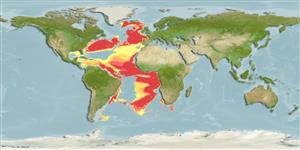>
Lophiiformes (Anglerfishes) >
Oneirodidae (Dreamers)
Etymology: Dolopichthys: Greek, 'dolops' or 'dolopos' = ambusher + Greek, 'ichthys' = fish (meaning "a fish that attacks by surprise") (Ref. 86949).
More on author: Regan.
Environment: milieu / climate zone / depth range / distribution range
Ökologie
seewasser bathypelagisch; tiefenbereich 600 - 2000 m (Ref. 86949). Deep-water
Atlantic Ocean: occurring from tropical to temperate waters.
Size / Gewicht / Alter
Maturity: Lm ? range ? - ? cm
Max length : 11.5 cm SL (female)
Kurzbeschreibung
Morphologie | Morphometrie
Rückenflossenweichstrahlen (insgesamt): 7; Afterflossenweichstrahlen: 5 - 6. Metamorphosed females distinguished by the following characteristics: long illicium and unique escal morphology; escal bulb with 2 distally bifurcating papillae on dorsal midline, each darkly pigmented and well separated from each other; absence of connecting membrane between anterior and posterior filaments of posterior escal appendage; anterior filament of posterior appendage darkly pigmented in 75-mm specimen; teeth on lower jaw 53-260; teeth on vomer 0-3; dorsal fin rays 7; anal fin rays 5-6; pectoral fin rays 20-21; illicium length 43.9-75.3% SL (Ref. 86949).
Also mesopelagic (Ref. 10524).
Life cycle and mating behavior
Geschlechtsreife | Fortpflanzung | Ablaichen | Eier | Fecundity | Larven
Bertelsen, E., 1990. Oneirodidae. p. 498-507. In J.C. Quero, J.C. Hureau, C. Karrer, A. Post, and L. Saldanha (eds.) Check-list of the fishes of the eastern tropical Atlantic (CLOFETA). JNICT, Lisbon; SEI, Paris; and UNESCO, Paris. Vol. 1. (Ref. 10524)
IUCN Rote Liste Status (Ref. 130435)
Bedrohung für Menschen
Harmless
Nutzung durch Menschen
Mehr Information
NamenSynonymeMetabolismusRäuberÖkotoxikologieFortpflanzungGeschlechtsreifeAblaichenSpawning aggregationFecundityEierEientwicklung
Alter/GrößeWachstumLänge-GewichtLänge-LängeLängenhäufigkeitenMorphometrieMorphologieLarvenLarven Pop.Dyn.RekrutierungDichteBRUVS
ReferenzenAquakulturAquakultur ProfilZuchtlinienGenetikElectrophoresesVererbbarkeitKrankheitenVerarbeitungNutrientsMass conversion
PartnerBilderStamps, Coins Misc.LauteCiguateraGeschwindigkeitSchwimmstilKiemenoberflächeOtolithsGehirngrößeSehfähigkeit
Tools
Zusatzinformationen
Download XML
Internet Quellen
Estimates based on models
Preferred temperature (Ref.
123201): 3.1 - 4.9, mean 4.5 °C (based on 38 cells).
Phylogenetic diversity index (Ref.
82804): PD
50 = 0.5078 [Uniqueness, from 0.5 = low to 2.0 = high].
Bayesian length-weight: a=0.01995 (0.00906 - 0.04395), b=3.01 (2.83 - 3.19), in cm total length, based on all LWR estimates for this body shape (Ref.
93245).
Trophic level (Ref.
69278): 3.8 ±0.5 se; based on size and trophs of closest relatives
Widerstandsfähigkeit (Ref.
120179): mittel, Verdopplung der Population dauert 1,4 - 4,4 Jahre. (Preliminary K or Fecundity.).
Fishing Vulnerability (Ref.
59153): Low vulnerability (10 of 100).
